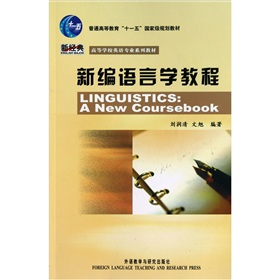《新编语言学教程》以《高等学校英语专业英语教学大纲》为基本依据,参考借鉴大量国内外同类教材,具有以下主要特点:内容丰富,重点突出。涵盖语言学领域的核心内容;反映当代语富学的最新理论和研究成果;注重可操作性,讲练结合,便于教授和学习;语言简明生动,深入浅出,富有启发性。
Contents
Chapter 1 Introduction
1.1 Linguistics
1.1.1 Definition of linguistics
1.1.2 Linguistics versus traditional grammar
1.1.3 Use of studying linguistics
1.1.4 Scope of linguistics
1.2 Language
1.2.1 Definition of language
1.2.2 Origin of language
1.2.3 Design features of language
1.2.4 Functions of language
1.3 Some Major Concepts in Linguistics
1.3.1 Descriptive and prescriptive grammars
1.3.2 Synchronic and diachronic linguistics
1.3.3 Langue and parole
1.3.4 Competence and performance
1.3.5 Syntagmatic and paradigmatic relations
1.3.6 Functionalism and formalism
Exercises and Discussion Questions
Sources and Suggestions for Further Reading
Supplementary Readings
Chapter 2 The Sounds of Language
2.1 Introduction
2.2 Phonetics
2.2.1 Articulators and their functions
2.2.2 Voiced and voiceless sounds
2.2.3 Nasal and oral sounds
2.2.4 Classification of English speech sounds
2.2.4.1 English consonants
2.2.4.2 English vowels
2.2.5 Variations of sounds
2.2.5.1 Liaison
2.2.5.2 Elision and assimilation
2.3 Phonology
2.3.1 Phonemes: the phonological units of language
2.3.2 Minimal pairs and sets
2.3.3 Free variation
2.3.4 Distinctive features
2.3.5 Syllables and consonant clusters
2.3.6 Suprasemental features
2.3.6.1 Stress
2.3.6.2 Intonation
Exercises and Discussion Questions
Sources and Suggestions for Further Reading
Supplementary Readings
Chapter 3 Morphology
3.1 Introduction
3.2 Morphemes
3.2.1 Free morphemes
3.2.2 Bound morphemes
3.3 Morphs and AIIomorphs
3.4 Types of Word Formation
3.4.1 Compounding
3.4.2 Derivation
3.4.3 Other ways of word formation
3.4.3.1 Conversion
3.4.3.2 Backformation
3.4.3.3 Clipping
3.4.3.4 Blending
3.4.3.5 Acronym
3.4.3.6 Initialism
Exercises and Discussion Questions
Sources and Suggestions for Further Reading
Supplementary Readings
Chapter 4 Syntax
4.1 Introduction
4.2 Word classes
4.3 The Prescriptive Approach
4.4 The Descriptive Approach
4.4.1 Structural analysis
4.4.2 Immediate constituent analysis
4.5 Constituent Structure Grammar
4.6 Transformational Grammar
4.7 Systemic Functional Grammar
Exercises and Discussion Questions
Sources and Suggestions for Further Reading
Supplementary Readings
Chapter 5 Semantics
5.1 Definition of Semantics
5.2 Approaches to Meaning
5.2.1 Meaning as naming
5.2.2 Meaning as concept
5.2.3 Meaning as behavior
5.2.4 Meaning as context
5.2.5 Meaning as truth conditions
5.3 Word Meaning
5.3.1 Sense and reference
5.3.2 Seven types of meaning
5.3.2.1 Conceptual meaning
5.3.2.2 Connotative meaning
5.3.2.3 Social meaning
5.3.2.4 Affective meaning
5.3.2.5 Reflective meaning
5.3.2.6 Collocative meaning
5.3.2.7 Thematic meaning
5.3.3 Semantic fields
5.3.4 Componential analysis
5.3.5 Semantic relationships between words
5.3.5.1 Homonymy
5.3.5.2 Polysemy
5.3.5.3 Homophony
5.3.5.4 Synonymy
5.3.5.5 Antonymy
5.3.5.6 Hyponymy
5.3.5.7 Meronymy
5.4 Sentence Meaning
5.4.1 Sentence and proposition
5.4.2 Semantic roles
5.4.3 Semantic relationships between sentences
5.4.3.1 Entailment
5.4.3.2 Presupposition
5.4.3.3 Synonymy
5.4.3.4 Inconsistency
5.4.3.5 Implicature
Exercises and Discussion Questions
Sources and Suggestions for Further Reading
Supplementary Readings
Chapter 6 Pragmatics
6.1 Introduction
6.2 Micropragmatics
6.2.1 Reference
6.2.2 Deixis
6.2.3 Anaphora
6.2.4 Presupposition
6.3 Macropragmatics
6.3.1 Speech act theory
6.3.1.1 Illocutionary acts
6.3.1.2 Classification of illocutionary acts
6.3.1.3 Indirect speech acts
6.3.2 The Cooperative Principle
6.3.2.1 The Cooperative Principle and its maxims
6.3.2.2 Conversational implicatures
6.3.3 The Politeness Principle
Exercises and Discussion Questions
Sources and Suggestions for Further Reading
Supplementary Readings
Chapter 7 Discourse Analysis
7.1 Discourse and Discourse Analysis
7.2 Information Structure
7.2.1 Given and new information
7.2.2 Topic and comment
7.2.3 Contrast
7.3 Cohesion and Coherence
7.3.1 Cohesion
7.3.1.1 Reference
7.3.1.2 Substitution
7.3.1.3 Ellipsis
7.3.1.4 Conjunction
7.3.1.5 Lexical cohesion
7.3.2 Coherence
7.4 Discourse Markers
7.5 Conversational Analysis
7.5.1 Adjacency pairs
7.5.2 Preference structure
7.5.3 Presequences
7.6 Critical Discourse Analysis
Exercises and Discussion Questions
Sources and Suggestions for Further Reading
Supplementary Readings
Chapter 8 Sociolinguistics
8.1 Introduction
8.2 Language Varieties
8.2.1 Standard language
8.2.2 Dialects
8.2.3 Registers
8.2.4 Pidgins and creoles
8.2.5 Language planning
8.3 Choosing a Code
8.3.1 Diglossia
8.3.2 Bilingualism and multilingualism
8.3.3 Code-switching
8.4 Linguistic Taboos and Euphemisms
8.5 Language and Gender
Exercises and Discussion Questions
Sources and Suggestions for Further Reading
Supplementary Readings
Chapter 9 Psycholinguistics
9.1 Introduction
9.2 Language Acquisition
9.3 Language Production
9.3.1 Conceptualization
9.3.2 Formulation
9.3.3 Articulation
9.3.4 Self-regulation
9.4 Language Comprehension
9.4.1 Sound comprehension
9.4.2 Word comprehension
9.4.3 Sentence comprehension
9.4.4 Text comprehension
9.5 Language and Thought
9.5.1 Language determines thought
9.5.2 Thought determines language
Exercises and Discussion Questions
Sources and Suggestions for Further Reading
Supplementary Readings
Chapter 10 Cognitive Linguistics
10.1 Introduction
10.2 Categorization and Categories
10.2.1 The classical theory
10.2.2 Prototype theory
10.2.3 Levels of categorization
10.3 Conceptual Metaphor and Metonymy
10.3.1 Conceptual metaphor
10.3.2 Conceptual metonymy
10.4 Iconicity
10.4.1 Iconicity of order
10.4.2 Iconicity of distance
10.4.3 Iconicity of complexity
10.5 Grammaticalization
Exercises and Discussion Questions
Sources and Suggestions for Further Reading
Supplementary Readings
Chapter 11 Language Acquisition
11.1 First Language Acquisition
11.1.1 The behaviorist approach
11.1.2 The innateness approach
11.1.3 Stages of acquiring the first language
11.2 Second Language Acquisition
11.2.1 Contrastive analysis
11.2.2 Error analysis
11.2.3 Interlanguage
11.3 Individual Differences in Second Language Acquisition
11.3.1 Language aptitude
11.3.2 Cognitive style: field dependence and field independence
11.3.3 Personality traits
11.3.4 Learning strategies
11.4 Instruction and L2 Acquisition
11.4.1 Form-focused instruction
11.4.2 Learner-instruction matching
11.4.3 Strategy training
Exercises and Discussion Questions
Sources and Suggestions for Further Reading
Supplementary Readings
Chapter 12 Applied Linguistics
12.1 Introduction
12.2 Language Teaching
12.2.1 The grammar-translation method
12.2.2 The direct method
12.2.3 The audiolingual method
12.2.4 Situational language teaching
12.2.5 Functional language teaching
12.2.6 Communicative language teaching
12.2.7 Other approaches
12.3 Testing
12.3.1 The main types of language tests
12.3.2 Principles of language testing
12.4 Summary
Exercises and Discussion Questions
Sources and Suggestions for Further Reading
Supplementary Readings
Glossary
Index
装 帧:平装
页 数:358
开 本:16开
纸 张:胶版纸
